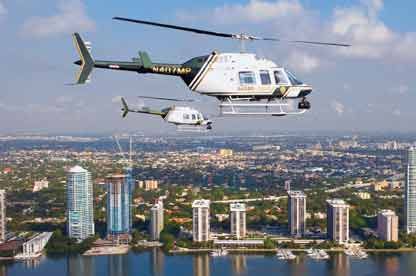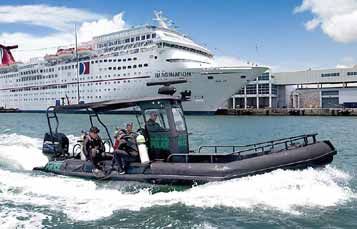By Dale Stockton
Click here to subscribe to Law Officer Magazine

Miami-Dade County, Fla., is one of the most popular areas in the world for vacations and retirement. Policing such an area, however, can pose a real challenge. Covering an area of more than 2,100 square miles and populated by more than 2.3 million people, Miami-Dade County is a very diverse area. Further, the area has been impacted by the devastation of major hurricanes and the influx of refugees fleeing nearby Cuba. Rising to the challenge are the men and women of the Miami-Dade Police Department (MDPD), an agency composed of approximately 2,900 sworn officers and 1,700 support personnel.
Patrol Operations
Seventy percent of the department’s sworn personnel work one of three patrol divisions: north, south or uniform services. The north and south divisions are comprised of nine district stations that provide police and community-oriented services. The uniform services division is responsible for policing the busy Miami International Airport and Port of Miami, as well as activities at major events that require large-scale crowd control. The department has handled three Super Bowls with attendance that exceeded 80,000.
Patrol officers work staggered eight-hour shifts assigned by a bid system. They wear a tan shirt over dark brown pants with a tan stripe. Although officers still receive a revolver upon entry to the academy, most opt to carry a self-purchased semi-automatic handgun, and the academy has adapted to train with the semi-auto from the outset. Body armor is provided through a voucher system that allows the officers to select what best fits their needs.
Patrol officers drive primarily Ford Crown Victorias equipped with prisoner cages and mobile data systems. Officers can carry shotguns or carbines after meeting approved training requirements. Officers past their probation period are assigned their own patrol cars, which allows them to grow familiar with a specific vehicle and take responsibility for its proper care and maintenance. Officers can drive the vehicle to and from work, as well as off-duty within specified guidelines.
Community Policing
The department addresses Miami’s tourist safety through an effort called Tourist Oriented Police (TOP) administered by the airport district. TOP personnel are specially trained in assisting tourists and in methods of preventing tourist crime in and around the Miami International Airport area. A program known as Business Against Narcotics and Drugs (BAND), a joint venture between the department and the Greater Miami Chamber of Commerce, focuses on establishing a drug-free workplace and provides on-site educational resources to businesses.
The Strategic & Specialized Investigations Bureau
This bureau consists of the street gang unit, criminal intelligence unit, organized crime, technical operations and homeland security. The street gang unit gathers intelligence on street gangs and assists other entities with gang-related problems and investigations. The career criminal section tackles career criminals and repeat offenders. The criminal intelligence unit gathers and reports intelligence information for the department, including targeting groups with a link to terrorism or subversive activities. Organized crime efforts include illegal lottery, bookmaking, money laundering, illegal bingo, murder, organized prostitution and pornography. Technical operations supports investigators with some of the latest high-tech surveillance equipment. Homeland security coordinates emergency response and enhanced infrastructure security at Miami-Dade critical sites.
The investigative support division includes the crime laboratory, crime scene investigations (CSI) and property and evidence bureaus. The nationally accredited crime laboratory provides all levels of expert scientific analysis and is available to other agencies in the county. The CSI section has received national recognition for innovative crime-scene investigative techniques and training programs. As evidence of the volume of narcotics in Miami-Dade, consider that the analytical section of the crime lab has 10 full-time criminalists devoted solely to the task of analyzing narcotics seized in the county.
MDPD has aggressively used some of Florida’s progressive DNA legislation to solve crimes through the convicted offender DNA non-compliance clearinghouse enforcement squad. Established in 2004 to obtain DNA samples from certain categories of offenders, this unit has collected more than 250 court-ordered DNA samples and closed more than 33 cold cases.
The Special Patrol Bureau
 This bureau includes a number of specialized functions that are divided into two major sections. The tactical operations section includes the special-response team (SRT), K-9, bomb and critical incident management. The specialized patrol and events section includes the aviation, marine-patrol, motorcycle and special-events units.
This bureau includes a number of specialized functions that are divided into two major sections. The tactical operations section includes the special-response team (SRT), K-9, bomb and critical incident management. The specialized patrol and events section includes the aviation, marine-patrol, motorcycle and special-events units.
Miami-Dade’s SRT is one of the most highly trained in the country and comprises 36 sworn personnel divided into three teams. In addition to tactical response, responsibilities include high-risk search warrants (3-4 per week) and dignitary protection.
When SRT rolls on a callout, the nine-person bomb squad assists in breaching and distraction efforts, making them extremely useful in hostage incidents, says Eloy Nuñez, emergency operations lieutenant for SRT. The bomb squad has a new foam tent system it can place over a suspected device and fill with foam. “The foam is capable of neutralizing most biological agents and deadens the impact or percussion of the explosion,” says Nuñez.
The SRT personnel’s capabilities include assaulting an aircraft, a specialty made necessary by the busy Miami International Airport. “We have a specialized ramp that attaches to a Suburban and is used for aircraft assaults,” Nuñez explains. “The ramp extends so the team can make a rapid entry to an aircraft. We train extensively on aircraft assault.”
The MDPD’s SRT includes a wide array of specialized equipment, including two Lenco armored vehicles, pole cams, fiber-optic cameras and robots. According to Nuñez, the robots are beginning to play a new role in tactical assaults. “We’ve taken a bomb disposal robot and modified it for other uses,” he says. “For instance, we’ll use the robot to place a cookie-cutter explosive charge. Once a hole is opened up to the structure, we’ll use the same robot with a special nozzle that we came up with to dispense gas. This puts in a lot more gas and really lessens the chance of any fires,” Nuñez says.
The marine patrol, aviation, motorcycle and K-9 units also operate under the special patrol bureau. The 24 personnel assigned to marine patrol work out of four different marine offices and are primarily concerned with the Port of Miami and the Miami River. Aviation consists of 18 personnel who fly and maintain four Bell 206 L-4 helicopters and two Cessna airplanes. Available around the clock, the unit uses officers for both pilot and observer functions. The motorcycle unit handles traffic and escort responsibilities and maintains a DUI squad. Comprised of 30 personnel, the primary vehicle of choice is the Harley Davidson Road King. K-9 operations include 15 handlers, three of whom are sergeants. Many of the handlers work with two dogs, and the department includes patrol, bomb, drug, cadaver and tracking capabilities. K-9 units operate in patrol cars except for handlers that handle more than one dog; these officers utilize a Suburban designed to carry both animals.
Training
The MDPD training bureau has developed into a premier training center, providing curriculums designed to meet departmental training objectives as well as individual educational needs. Officers can even receive a college degree through the training center due to arrangements with multiple colleges in the area. Fifty percent of college tuition is eligible for reimbursement. It offers more than 200 training courses, and officers from all over the world have attended training. In addition to providing refresher and in-service training to more than 3,000 officers each year, the bureau is responsible for academy training, which is 41 weeks and includes one week of in-field training six weeks before graduation. Field training lasts almost four months, culminating in a two-week shadow period where the trainee operates a single-person unit followed by a training officer in plainclothes.
The need for quality recruits remains great, and the department usually runs four to five academies a year, according to Lt. Bernard Bullock, who oversees the basic academy training functions. “We’ll start with about 44 each class and graduate around 30 to 35 per session,” he says. According to Bullock, department pay and benefits are slightly above average for this area of the country, and the department is an attractive place to work. Retirement and benefits are available after 25 years of service, regardless of age. In other words, officers who start in their early 20s can retire in their late 40s. Retirement pay is based on 3 percent of the average of the last five-years of pay multiplied by the number of years of service. There is no pay deduction for retirement, and officers are vested after six years. There is also a deferred retirement program (commonly called DROP) that allows officers to continue working at full pay and invest their retirement pay into a special state fund. “Our best selling point is that we are a very large department and we have a lot of upward and lateral movement. We’re very diverse in function and have a lot of specialties. Over the course of your career, you could work in
a lot of different areas,” Bullock says.
The MDPD has a reputation as a progressive agency, which is not surprising when you consider these comments from Nuñez: “What I enjoy most about this agency is that innovation is encouraged. Even as a road patrol officer, ideas flow and people listen. There’s always been the ability for people to bring forward new ideas.” Well said and reflective of a quality department.
Dale Stockton is the editor of Law Officer.


